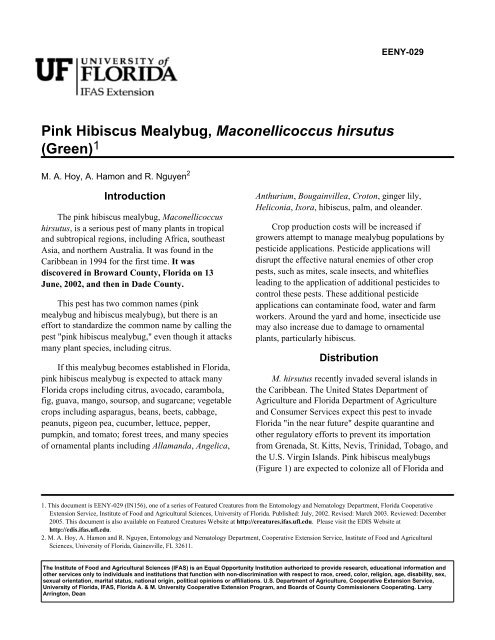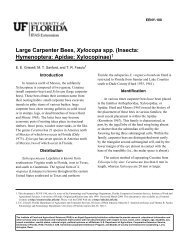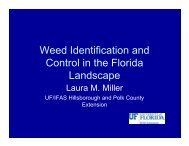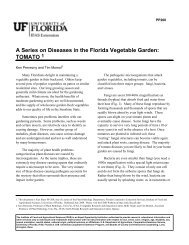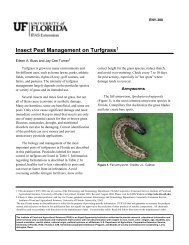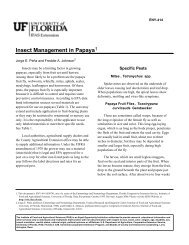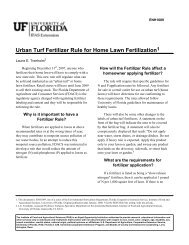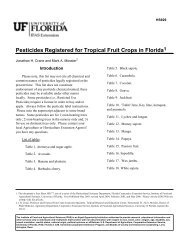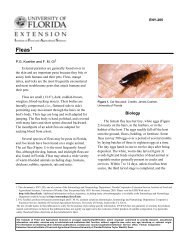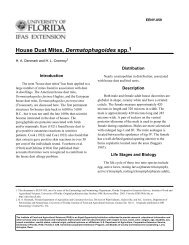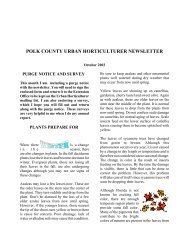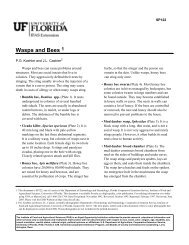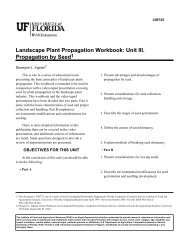Pink Hibiscus Mealybug, Maconellicoccus hirsutus - Polk County ...
Pink Hibiscus Mealybug, Maconellicoccus hirsutus - Polk County ...
Pink Hibiscus Mealybug, Maconellicoccus hirsutus - Polk County ...
Create successful ePaper yourself
Turn your PDF publications into a flip-book with our unique Google optimized e-Paper software.
EENY-029<br />
<strong>Pink</strong> <strong>Hibiscus</strong> <strong>Mealybug</strong>, <strong>Maconellicoccus</strong> <strong>hirsutus</strong><br />
(Green) 1<br />
M. A. Hoy, A. Hamon and R. Nguyen 2<br />
Introduction<br />
The pink hibiscus mealybug, <strong>Maconellicoccus</strong><br />
<strong>hirsutus</strong>, is a serious pest of many plants in tropical<br />
and subtropical regions, including Africa, southeast<br />
Asia, and northern Australia. It was found in the<br />
Caribbean in 1994 for the first time. It was<br />
discovered in Broward <strong>County</strong>, Florida on 13<br />
June, 2002, and then in Dade <strong>County</strong>.<br />
This pest has two common names (pink<br />
mealybug and hibiscus mealybug), but there is an<br />
effort to standardize the common name by calling the<br />
pest "pink hibiscus mealybug," even though it attacks<br />
many plant species, including citrus.<br />
If this mealybug becomes established in Florida,<br />
pink hibiscus mealybug is expected to attack many<br />
Florida crops including citrus, avocado, carambola,<br />
fig, guava, mango, soursop, and sugarcane; vegetable<br />
crops including asparagus, beans, beets, cabbage,<br />
peanuts, pigeon pea, cucumber, lettuce, pepper,<br />
pumpkin, and tomato; forest trees, and many species<br />
of ornamental plants including Allamanda, Angelica,<br />
Anthurium, Bougainvillea, Croton, ginger lily,<br />
Heliconia, Ixora, hibiscus, palm, and oleander.<br />
Crop production costs will be increased if<br />
growers attempt to manage mealybug populations by<br />
pesticide applications. Pesticide applications will<br />
disrupt the effective natural enemies of other crop<br />
pests, such as mites, scale insects, and whiteflies<br />
leading to the application of additional pesticides to<br />
control these pests. These additional pesticide<br />
applications can contaminate food, water and farm<br />
workers. Around the yard and home, insecticide use<br />
may also increase due to damage to ornamental<br />
plants, particularly hibiscus.<br />
Distribution<br />
M. <strong>hirsutus</strong> recently invaded several islands in<br />
the Caribbean. The United States Department of<br />
Agriculture and Florida Department of Agriculture<br />
and Consumer Services expect this pest to invade<br />
Florida "in the near future" despite quarantine and<br />
other regulatory efforts to prevent its importation<br />
from Grenada, St. Kitts, Nevis, Trinidad, Tobago, and<br />
the U.S. Virgin Islands. <strong>Pink</strong> hibiscus mealybugs<br />
(Figure 1) are expected to colonize all of Florida and<br />
1. This document is EENY-029 (IN156), one of a series of Featured Creatures from the Entomology and Nematology Department, Florida Cooperative<br />
Extension Service, Institute of Food and Agricultural Sciences, University of Florida. Published: July, 2002. Revised: March 2003. Reviewed: December<br />
2005. This document is also available on Featured Creatures Website at http://creatures.ifas.ufl.edu. Please visit the EDIS Website at<br />
http://edis.ifas.ufl.edu.<br />
2. M. A. Hoy, A. Hamon and R. Nguyen, Entomology and Nematology Department, Cooperative Extension Service, Institute of Food and Agricultural<br />
Sciences, University of Florida, Gainesville, FL 32611.<br />
The Institute of Food and Agricultural Sciences (IFAS) is an Equal Opportunity Institution authorized to provide research, educational information and<br />
other services only to individuals and institutions that function with non-discrimination with respect to race, creed, color, religion, age, disability, sex,<br />
sexual orientation, marital status, national origin, political opinions or affiliations. U.S. Department of Agriculture, Cooperative Extension Service,<br />
University of Florida, IFAS, Florida A. & M. University Cooperative Extension Program, and Boards of <strong>County</strong> Commissioners Cooperating. Larry<br />
Arrington, Dean
<strong>Pink</strong> <strong>Hibiscus</strong> <strong>Mealybug</strong>, <strong>Maconellicoccus</strong> <strong>hirsutus</strong> (Green) 2<br />
spread north into southern Georgia. Because pink<br />
hibiscus mealybug attacks so many crop and<br />
ornamental plants, populations could become<br />
common on many plant species in Florida.<br />
Figure 3. Adult male pink hibiscus mealybug,<br />
<strong>Maconellicoccus</strong> <strong>hirsutus</strong> (Green). Notice the two long<br />
waxy "tails." Credits: Marshall Johnson, Department of<br />
Entomology, University of Hawaii at Manoa<br />
Figure 1. <strong>Pink</strong> hibiscus mealybugs, <strong>Maconellicoccus</strong><br />
<strong>hirsutus</strong> (Green). Credits: Dale Meyerdirk, APHIS<br />
Description and Life Cycle<br />
The pink hibiscus mealybug has a high reproductive<br />
rate (females can deposit up to 600 eggs) and<br />
produces up to 15 generations per year, so pest<br />
populations can become very large.<br />
Adult mealybugs (Figure 2) are small (about 3<br />
mm long) and pink in body color but covered with a<br />
waxy secretion. The waxy filaments are short and<br />
females are usually obscured by this white mealy<br />
wax. When adults are crushed their body fluids are<br />
also pink. Adult males (Figure 3) are smaller than<br />
females, reddish brown and have one pair of wings.<br />
Males have two long waxy "tails."<br />
Figure 4. Freshly-laid eggs of the pink hibiscus mealybug,<br />
<strong>Maconellicoccus</strong> <strong>hirsutus</strong> (Green), are orange but become<br />
pink before they hatch. Credits: Marshall Johnson,<br />
Department of Entomology, University of Hawaii at Manoa.<br />
<strong>Pink</strong> hibiscus mealybug eggs overwinter in bark<br />
crevices, leaf scars, under bark, in the soil, tree boles,<br />
inside fruit clusters, and inside crumpled leaf clusters.<br />
Figure 2. Adult female (arrow) and offspring of the pink<br />
hibiscus mealybug, <strong>Maconellicoccus</strong> <strong>hirsutus</strong> (Green).<br />
Credits: Dale Meyerdirk, APHIS<br />
Females die shortly after depositing eggs.<br />
Freshly-laid eggs are orange, becoming pink before<br />
they hatch. Eggs are found in egg sacs (Figure 4).<br />
First instar nymphs (crawlers) of the pink hibiscus<br />
mealybug disperse by walking and by wind. Nymphs<br />
also can walk considerable distances to find suitable<br />
host plants. The life cycle takes about 23 to 30 days.<br />
Damage<br />
The pink hibiscus mealybug is not just an<br />
agricultural problem. This pest will attack ornamental<br />
plants in yards and parks.<br />
<strong>Pink</strong> hibiscus mealybug feeds on the soft tissues<br />
of many plant species and injects a toxic saliva that<br />
causes curling and contortion of leaves (Figure 5).<br />
The entire plant may be stunted and the shoot tips<br />
develop a bushy appearance. Buds may not flower
<strong>Pink</strong> <strong>Hibiscus</strong> <strong>Mealybug</strong>, <strong>Maconellicoccus</strong> <strong>hirsutus</strong> (Green) 3<br />
and stems may twist. Fruit may also be deformed. The<br />
mealybug excretes honeydew which encourages the<br />
development of black sooty mold. Very high<br />
mealybug populations can kill plants.<br />
internodes, deformed leaves and thickened twigs. In<br />
cotton, the growing parts are attacked, resulting in<br />
bunchy growth. Plants are stunted and produce fewer<br />
bolls of a smaller size. Boll opening is adversely<br />
affected and yield reduction occurs. In grapevines,<br />
the mealybug feeds on sprouts after pruning; heavily<br />
infested bunches shrivel and drop. In peanut, the<br />
mealybug can feed on the underground parts of the<br />
roots, pods, and pegs of the plant, resulting in stunted<br />
growth and poorly developed pods.<br />
Figure 5. <strong>Hibiscus</strong> shrub heavily infested by pink hibiscus<br />
mealybug, <strong>Maconellicoccus</strong> <strong>hirsutus</strong> (Green). Credits:<br />
Dale Meyerdirk, APHIS<br />
The level of feeding damage depends on the<br />
vigor of the infested plant; seedling trees and<br />
weakened trees are more susceptible. Shoots become<br />
twisted with shortened internodes, forming bunchy<br />
heads of small bushy leaves at the tips (Figure 6). The<br />
curled leaves can resemble viral damage, but this pest<br />
is not known to vector any diseases. Heavy<br />
infestations of young plants by the pink hibiscus<br />
mealybug may stunt their growth.<br />
Figure 6. Feeding on soft tissues of citrus by the pink<br />
hibiscus mealybug, <strong>Maconellicoccus</strong> <strong>hirsutus</strong> (Green),<br />
results in deformed leaves and shoots or "bunchy top."<br />
Fruit also may be deformed. Credits: Dale Meyerdirk,<br />
APHIS<br />
The mealybug is found on stems, leaves, buds,<br />
fruit and roots of many plants. On hibiscus (Figure<br />
7), the mealybug usually infests young twigs, causing<br />
deformed terminal growth due to shortening of the<br />
Figure 7. <strong>Hibiscus</strong> twig infested by pink hibiscus<br />
mealybug, <strong>Maconellicoccus</strong> <strong>hirsutus</strong> (Green). Credits: Dale<br />
Meyerdirk, APHIS<br />
Biological Control<br />
If the pink hibiscus mealybug invades Florida we<br />
will have to learn to live with this pest. Native natural<br />
enemies are expected to provide some control. We<br />
also believe this pest can be suppressed by the<br />
importation, rearing, release and establishment of<br />
host-specific natural enemies (classical biological
<strong>Pink</strong> <strong>Hibiscus</strong> <strong>Mealybug</strong>, <strong>Maconellicoccus</strong> <strong>hirsutus</strong> (Green) 4<br />
control). Such natural enemies are known to exist and<br />
can provide substantial control.<br />
The ladybug Cryptolaemus montrouzieri (Figure<br />
8) is known to feed on all stages of the mealybug.<br />
This beetle already is established in Florida and also<br />
is available commercially. The appropriate release<br />
rate for this ladybug is unknown. Predatory ladybugs<br />
may provide some suppression of high pest<br />
populations, but are not expected to provide adequate<br />
control of lower populations because the beetles<br />
require large numbers of mealybugs to survive.<br />
Figure 9. The Cryptolaemus larvae are covered with a<br />
white flocculent secretion and may be confused with pink<br />
hibiscus mealybugs but are important predators and<br />
should not be destroyed. Credits: Lance Osborne,<br />
University of Florida<br />
10) and have an exit hole where the adult wasp<br />
emerges.<br />
Figure 8. Predatory ladybugs, such as Cryptolaemus<br />
montrouzieri, may provide some suppression of high pink<br />
hibiscus mealybug, <strong>Maconellicoccus</strong> <strong>hirsutus</strong> (Green), pest<br />
populations, but are not expected to provide adequate<br />
control of lower populations because the beetles require<br />
large numbers of mealybugs to survive. Credits: Lance<br />
Osborne, University of Florida<br />
Cryptolaemus larvae (Figure 9) are covered with<br />
a white flocculent secretion and may be confused<br />
with pink hibiscus mealybugs but are important<br />
predators and should not be destroyed.<br />
The pink hibiscus mealybug is a good candidate<br />
for classical biological control. Several effective<br />
parasitoids are known in Asia and elsewhere. One<br />
parasitoid, Anagyrus kamali, completes a generation<br />
in less than half the time required for its host.<br />
Anagyrus kamali has been reported to be an<br />
outstanding natural enemy in Egypt and Hawaii and is<br />
able to dramatically suppress pink hibiscus mealybug<br />
populations. This parasitoid has been released on<br />
islands in the Caribbean and appears to be providing<br />
substantial control already. <strong>Pink</strong> hibiscus mealybugs<br />
parasitized by A. kamali produce "mummies" (Figure<br />
Figure 10. Two pink hibiscus mealybug, <strong>Maconellicoccus</strong><br />
<strong>hirsutus</strong> (Green), mummies (parasitized mealybugs). Note<br />
parasitoid exit hole on the bottom left mummy. Credits:<br />
Marshall Johnson, Department of Entomology, University<br />
of Hawaii at Manoa<br />
Several other parasitoid species also are known<br />
to attack the pink hibiscus mealybug. These<br />
parasitoids will be evaluated for their host specificity<br />
and may be released when more is known about their<br />
biology.<br />
Classical biological control projects often take<br />
several years to conduct. In order to shorten the time<br />
it will take to conduct a classical biological control<br />
program on the pink hibiscus mealybug, we have<br />
made contact with scientists in the native range of<br />
these pests for assistance in identifying sites where<br />
natural enemies can be collected and we have
<strong>Pink</strong> <strong>Hibiscus</strong> <strong>Mealybug</strong>, <strong>Maconellicoccus</strong> <strong>hirsutus</strong> (Green) 5<br />
obtained permits for importing these natural enemies<br />
into quarantine for evaluation. The USDA-APHIS<br />
also has agreed to provide starter cultures of<br />
parasitoids for evaluation, rearing, and release in<br />
Florida. Natural enemy species have been identified<br />
for which a substantial amount of information is<br />
available, which means that permission to get these<br />
species out of quarantine for mass rearing and release<br />
in Florida will be expedited once we know the pest is<br />
here in Florida.<br />
Insecticidal Control<br />
There is no known chemical control for this<br />
pest.<br />
<br />
What To Do If You Find This Pest<br />
If you find this mealybug pest on plants<br />
(especially hibiscus) at your home or farm, please<br />
send suspect pink hibiscus mealybug specimens to:<br />
Dr. Avas B. Hamon<br />
Division of Plant Industry<br />
PO Box 147100<br />
Gainesville, FL 32614-7100<br />
1. Preserve mealybugs on small pieces of host<br />
plant in isopropyl alcohol (rubbing alcohol).<br />
2. Include complete collection and location data.<br />
3. Include large mealybugs on small pieces of host<br />
material (Adult females are required for a proper<br />
identification). Please do not try to remove<br />
mealybugs from the host plant material.<br />
4. An alternative method is to use a freezer zip-lock<br />
bag with a small amount of rubbing alcohol<br />
(perhaps 5-10 ml) and place the small pieces of<br />
plant material with mealybugs inside the bag.<br />
Ship in a manner that will not crush the<br />
specimens. Please do not use the zip-lock bag<br />
without alcohol, as moisture and fungus will<br />
destroy the specimens.<br />
Selected References<br />
Beardsley, J. W. 1985. Notes and exhibitions.<br />
Anagyrus kamali Moursi and Anagyrus sp. Proc.<br />
Hawaiian Entomological Society 25: 27-28.<br />
Feiber, D. (10 July 2002). <strong>Pink</strong> hibiscus<br />
mealybug biological control program established.<br />
DOACS Press Releases.<br />
http://www.doacs.state.fl.us/press/07102002.html (24<br />
July 2002).<br />
Ghose, S. K. 1972. Biology of the<br />
mealybug, <strong>Maconellicoccus</strong> <strong>hirsutus</strong>. Indian<br />
Agriculture 16:323-332.<br />
Hall, W. J. 1921. The hibiscus mealybug.<br />
Ministry of Agriculture, Egypt, Technical Science<br />
Series, Entomology Section Bulletin17:1-28.<br />
Hall, W. J. 1921. The hibiscus mealybug in<br />
Egypt in 1925 with notes on the introduction of<br />
Cryptolaemus montrouzieri. Ministry of Agriculture,<br />
Egypt, Technical Science Series, Entomology Section<br />
Bulletin 70:1-15.<br />
Hamon, A.B. (February 2000). Pictures of<br />
pink hibiscus mealybug. FDACS-DPI.<br />
http://doacs.state.fl.us/~pi/enpp/ento/pink.htm (7<br />
October 2001).<br />
Kamal, M. 1951. Biological control projects<br />
in Egypt, with a list of introduced parasites and<br />
predators. Bull. Societ. Fouad 1 er d'Entomol. 35:<br />
205-220.<br />
Mani, M. 1989. A review of the pink<br />
mealybug - <strong>Maconellicoccus</strong> <strong>hirsutus</strong> (Green). Insect<br />
Sci. Applic. 10:157-167.<br />
Matilé-Ferrero, D. and J. Etienne. 1996.<br />
Presénce de la Cochenille de l'hibiscus,<br />
<strong>Maconellicoccus</strong> <strong>hirsutus</strong> á Saint-Martin<br />
(Hemiptera, Pseudococcidae). Revue fr. Ent. (N.S.)<br />
18:38.<br />
Moursi, A. A. 1948. Description of two new<br />
species of Anagyrus. Bull. Societ. Fouad 1er Entom.<br />
32:1-7.
<strong>Pink</strong> <strong>Hibiscus</strong> <strong>Mealybug</strong>, <strong>Maconellicoccus</strong> <strong>hirsutus</strong> (Green) 6<br />
Moursi, A. A. 1948. Anagyrus kamali Moursi,<br />
a parasite of the hibiscus mealybug, Phenacoccus<br />
<strong>hirsutus</strong> Green. Bull. Societ. Fouad 1 er Entom.<br />
32:9-16.<br />
Noyes, J. S. and M. Hayat. 1996. Oriental<br />
mealybug parasitoids of the Anagyrini<br />
(Hymenoptera:Eucyrtidae) CAB Intern., London.<br />
Osborne, L. (7 February 2002). The pink<br />
hibiscus mealybug.<br />
http://www.mrec.ifas.ufl.edu/lso/<strong>Pink</strong><strong>Mealybug</strong>.htm<br />
(7 March 2003).<br />
Rao, V. S. and S. Srinivasan. 1987.<br />
<strong>Maconellicoccus</strong> <strong>hirsutus</strong>, a new pest of groundnut in<br />
Andhra Pradesh. Entomon. 12(2):115.<br />
USDA-APHIS. 1997. Field releases of<br />
nonindigenous species of Anagyrus and<br />
Gyranusoidea (Hymenoptera: Encyrtidae) for<br />
biological control of pink hibiscus mealybug,<br />
<strong>Maconellicoccus</strong> <strong>hirsutus</strong> (Homoptera:<br />
Pseudococcidae). Environmental Assessment. 8 pp.<br />
USDA-APHIS. 1997. Program Aid No. 1606.<br />
Look out for the pink hibiscus mealybug. 11 pp.<br />
USDA-APHIS. 1996. Pathway risk<br />
assessment. <strong>Pink</strong> <strong>Mealybug</strong> from the Caribbean.<br />
61pp.<br />
Williams, D. J. 1996. A brief account of the<br />
hibiscus mealybug <strong>Maconellicoccus</strong> <strong>hirsutus</strong><br />
(Hemiptera: Pseudococcidae), a pest of agriculture<br />
and horticulture, with descriptions of two related<br />
species from southern Asia. Bulletin of<br />
Entomological Research 86: 617-628.


